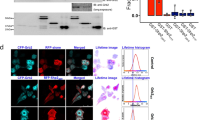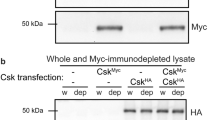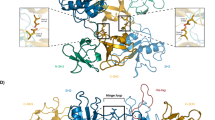Abstract
Bcr-Abl is an oncogenic tyrosine kinase expressed in tumor cells of CML and a subset of ALL which in its unregulated and activated state is thought to cause cell transformation and leukemia. Bcr-Abl contains several autophosphorylation sites which serve as potential docking sites for SH2-containing signaling molecules. Mutational analysis has indicated that these autophosphorylation sites play a critical role in the transforming capability of Bcr-Abl. It has been shown that the SH2-containing adapter protein Grb2 binds to the autophosphorylation site Tyr(p)177 whereby it couples Bcr-Abl to the Ras pathway. The biological consequences of this interaction, however, are presently unclear. A Tyr177-mutated Bcr-Abl which lacks the ability to interact with the Grb2-SH2 domain still transforms myeloid cells and generates tumors in nude mice. We performed a yeast two-hybrid screen to identify signaling proteins which bind to distinct Bcr-Abl autophosphorylation sites. Autophosphorylation of Bcr-Abl in yeast was accomplished by using the DNA binding protein LexA which permits dimerization and crossphosphorylation of the fused bait. Using a LexA-Bcr-Abl full length fusion protein as bait, we identified several SH2-containing proteins. Among them we confirmed molecules already shown by others to interact with Bcr-Abl, in vivo, including Grb2, PI-3-kinase and Crk indicating that dimerization in yeast leads to autophosphorylation of tyrosine residues crucial for Bcr-Abl signaling in vivo. More importantly, we identified the SH2-containing protein Grb10 as a new binding partner for Bcr-Abl. This binding occurs in a phosphotyrosine-dependent manner at Bcr sites of Bcr-Abl. Both Abl and Bcr alone, as well as a kinase-defective Bcr-Abl, failed to interact with Grb10 in yeast. Mutational analysis uncovered a new SH2 binding site in Bcr-Abl located between Bcr aa242-446, which is different from the Grb2 binding site. Binding could be demonstrated in vitro and also in vivo as shown by co-immunoprecipitation analysis in CML cells. Using a temperature sensitive Bcr-Abl stably overexpressed in hematopoetic cells, we demonstrated that complex formation of Grb10 with Bcr-Abl was kinase activation-dependent in vivo. Notably, a Bcr-Abl mutant protein (Bcr/1-242-Abl) which lacks the ability to interact with Grb10 partially alleviated IL-3 dependence of Ba/F3 cells, indicating that the Grb10/Bcr-Abl interaction is important for Bcr-Abl-induced IL-3 independence of Ba/F3 cells. In addition, the Bcr/1-242-Abl mutant has a reduced capacity to induce focus formation in fibroblasts.
This is a preview of subscription content, access via your institution
Access options
Subscribe to this journal
Receive 50 print issues and online access
$259.00 per year
only $5.18 per issue
Buy this article
- Purchase on Springer Link
- Instant access to full article PDF
Prices may be subject to local taxes which are calculated during checkout
Similar content being viewed by others
Author information
Authors and Affiliations
Rights and permissions
About this article
Cite this article
Bai, R., Jahn, T., Schrem, S. et al. The SH2-containing adapter protein GRB10 interacts with BCR-ABL. Oncogene 17, 941–948 (1998). https://doi.org/10.1038/sj.onc.1202024
Received:
Revised:
Accepted:
Published:
Issue Date:
DOI: https://doi.org/10.1038/sj.onc.1202024
Keywords
This article is cited by
-
F604S exchange in FIP1L1-PDGFRA enhances FIP1L1-PDGFRA protein stability via SHP-2 and SRC: a novel mode of kinase inhibitor resistance
Leukemia (2015)
-
Grb10 is involved in BCR-ABL-positive leukemia in mice
Leukemia (2015)
-
Grb10 is a dual regulator of receptor tyrosine kinase signaling
Molecular Biology Reports (2014)
-
Phosphorylation of tyrosine 393 in the kinase domain of Bcr-Abl influences the sensitivity towards imatinib in vivo
Leukemia (2003)
-
SMIF, a Smad4-interacting protein that functions as a co-activator in TGFβ signalling
Nature Cell Biology (2002)



